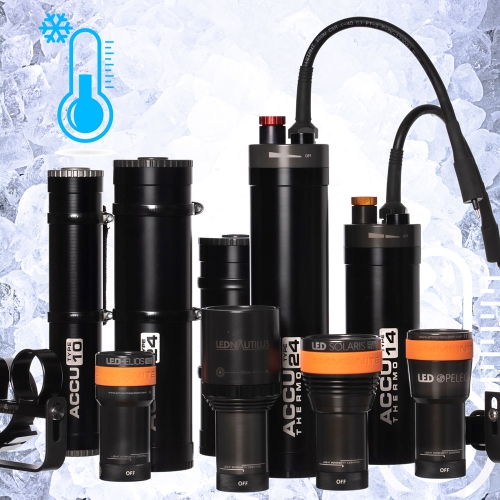Battery capacity in cold water
For years, we heard the questions about how much the operating time of our batteries in cold water is shortening. Specifically it is about the effect of low water temperature on the most important battery parameter - capacity.
The issue of capacity loss has been raised for years. I have heard it for at least 20 years. Since the beginning of my diving career, when Ni-Mh batteries were the most popular type of batteries.
Today, practically the only type of batteries supplying power to our torches and diving heating are Li-Ion batteries, but the anxiety of loss of capacity has survived and is still present among divers. Technology has changed but fears have survived. Why are they so wrong? I will explain below.
Ni-Mh batteries were widely used in older electrical equipment. Despite their numerous advantages they have several significant disadvantages.
Contrary to popular belief they have a memory effect, although reduced compared to old Ni-Cd, but still. They are characterized by significant self-discharge - their electric charge clearly decreases when they are not used - so they need charging up and charging up is a memory effect so the wheel closes.
They are not permanent - especially in packages. So packages based on Ni-Mh lose their usability very fast.
The only undeniable advantage of Ni-Mh batteries is safety. Ni-Mh batteries can be transported completely stress-free without fear of "arresting" our battery, but about it in a next article.
Times have changed and today's technology. The most common power source for diving systems are Li-Ion battery packages.
This type of battery has long paved the way for applications in diving equipment.
I even know examples of companies in the underwater lighting industry that have sworn that they will never use Li-ion batteries in their equipment and they are no longer on the market today.
But let's return to the issue of low temperatures and a decrease in capacity. Where did this belief come from?
Most likely it survived due to the combination of two situations - namely leaving the equipment and with it the batteries Ni-Mh on a cold autumn or winter night in a "dive truck".
Ni-Mh batteries show a significant voltage drop at temperatures below 0 ° C. It becomes so low that some devices stop working or go into safe mode. And it could happen that the battery, which was packed into the car at room temperature, was fully charged. When cooled at a temperature below 0oC getting a voltage drop of a dozen or more, in extreme cases, several dozen percent.
It happened when we left our equipment for the night in the car and went to have fun. At night the temperature drops to - 8 degrees and during the morning dive our torch did not "cooperate".
So I think that this myth comes from the true fact about Ni-Mh batteries survived in relation to Li-Ion batteries despite the evolution of electric diving systems. Ni-Mh batteries practically do not exist anymore in diving equipment.
So what characterizes lithium batteries so popular nowadays for low temperatures?
Li-on batteries are great at + 5 ° C to -5 ° C - on a typical autumn or winter day and in water below the thermocline.
In this temperature range they lose up to a maximum of 10% of their original capacity. For comparison classic nickel-hydrogen Ni-Mh up to 30%. And the colder the worse.
Lithium batteries do not show a significant decrease in capacity practically down to -20 ° C.
Of course - this is a situation of possible storage of batteries, not diving, because the water always has a positive temperature.
First of all, we can delay this small effect of capacity decrease by storing equipment immediately before diving in a properly heated room.
Secondly, the housing and package design is our ally. For physical reasons the battery pack can be compared to a liquid container. The question is how long does it take to cool such a container? Anyone who tried to cool a bottle of beer during a warm day by throwing it on a string into the lake.
Thirdly, remember taht the battery pack is usually enclosed in a round housing that insulates it from the environment especially if it is made of special material as polymer (Delrin®) and hard anodised aluminium. And due to the angular shape of the packet it is additionally surrounded by a layer of air. So a lot of time will pass to cool the battery to ambient temperature (water) - about 4oC.
Finally, about storing batteries when you are not diving. And now we usually don't dive (I am writing this article during COVID-19 worldwide pandemic).
Li-Ion batteries "don't like to be in to warm atmosphere" - the ideal temperature for storage is 8-12̊ C.
At this temperature, a loss of capacity in charged up to 40% unused battery is only up to 2%. But if we charge the battery to 100%, it can lose up to 6% during "aging".
Batteries also don't like to be charged to 100%.This is an information for those who care about their equipment because the batteries that reach to our repair shop after 5-6 years have a capacity drop to 20% but it is worth knowing that by charging the battery to 80% capacity, you can extend its life by twice .
Take care of your batteries and they will serve you for years.

